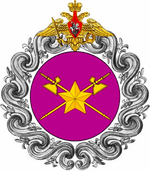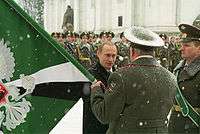Rear of the Russian Armed Forces
The Rear of the Armed Forces of the Russian Federation (RAF-RF) (Russian: Тыл Вооружëнных Сил Российской Федерации, romanized: Tyl Vooruzhonnykh Sil Rossiyskoy Federatsii), often referred to in English as the rear services, is an organization of support services for the Russian Armed Forces.
| Тыл Вооружëнных Сил Российской Федерации Rear of the Armed Forces of the Russian Federation | |
|---|---|
  RAFRF great emblem and flag | |
| Active | 1992-2010 |
| Country | Russian Federation |
| Branch | Russian Armed Forces |
| Role | Logistics and support |
| Anniversaries | August 1 |
| Commanders | |
| Current commander | Army General Dmitry Bulgakov (2008-2010) |
The Rear of the Armed Forces includes an unusually diverse range of services, for example medical services, firefighters, logistical services, economic analysts, scientific units, and combat-ready formations for maintaining and protecting rear installations such as pipelines and railways. The Rear also has its own central staff organization.
The Rear of the Armed Forces is separate to each force's own rear services, e.g. the Rear of the Ground Forces, Rear of the Strategic Missile Forces, etc. In principle, these rear organizations are co-ordinated by the Rear of the Armed Forces.

History
The formation of Russian rear services is commonly ascribed to the year 1700, when Peter I signed an order On Management of the Grain Supplies of All Military People to okolnichy Yazykov with Elevating Him to Commissary General After That, thus forming the first supply service (Proviantskiy Prikaz). In 1711 all military supply services were incorporated in the army. However the word "rear" (тыл) as a separate term appeared only in the Russo-Japanese War of 1904-1905. Shortly after the onset of Operation Barbarossa in 1941, the Russian rear services experienced severe difficulties, which were fixed after the order On Organization of the Rear Services Management Office of the Red Army... was enacted by the People's Commissar for Defence, Marshal of the Soviet Union Semyon Timoshenko. The Rear Services of the Armed Forces of the Soviet Union were renamed as the Rear Services of the Armed Forces of Russia in 1991.
In 2010 it was transformed into the Logistical Support[1].
Current Agencies
The rear services of the Armed Forces of Russia currently includes:
- Main Military Medical Department of the RF Defence Ministry
- Main Department of Military Transportation of the RF Defence Ministry
- Central Automobile Road Department of the RF Defence Ministry
- Central Department of Rocket and Other Fuel of the RF Defence Ministry
- Central Food Department of the RF Defence Ministry
- Central Clothing Department of the RF Defence Ministry
- Fire Rescue and Local Defence Service of the RF Armed Forces
- Veterinary and Sanitary Service of the RF Armed Forces
- Economic Security Department of the RF Armed Forces
- Main Trade Department of the RF Defence Ministry
- Main Department of Active Leisure of the RF Defence Ministry
- Agricultural Department of the RF Defence Ministry
- Military Science Committee of the RF Armed Forces Rear
- Secretariat of the Chief of the RF Armed Forces Rear
- Personnel Department of the RF Armed Forces Rear
- Signal Troops of the RF Armed Forces Rear
- Russian Railway Troops (since 5 October, 2004)
- Russian Automobile Troops
- Russian Road Troops
- Russian Pipeline Troops
Aside from these, all the branches of the Russian Armed Forces maintain their respective rear services, which report to the Rear Services HQ.
References
- Материально-техническое обеспечение Вооруженных Сил Российской Федерации (in Russian). Ministry of Defence of the Russian Federation. Retrieved 28 November 2017.
External links
- (in Russian) Official website
- (in Russian) Defence Ministry. The Rear Services of the Armed Forces
.svg.png)